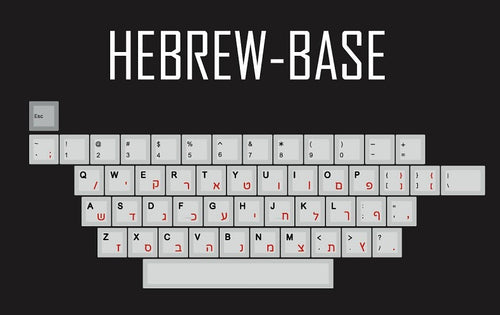


kprepublic 139 Hebrew root font letter Cherry profile Dye Sub Keycap Set PBT black red
$17.30 $17.30

140 PBT Keycaps(A product by KPrepublic)
Compatible with Cherry MX switches and related clones, these keycaps are made of super-durable PBT plastic. They’re designed in Cherry profile for kinds of keyboards(such as XD64\GH60\RS96\Tada68.......), and they’re finished with dye-sublimated legends. Total comes with max 140 keycaps (5 kits)
Specs
PBT plastic
Thick PBT
Shading Light Keycaps
Dye sublimation legends
Color: Familar with DSA Grinate or XDA Milestone, so the Alpha kit color is light white grey:)
Compatible with MX switches (and clones)
Cherry profile
3U/6U/625U/7U are Convex Spacebar
layout is as following pic
Included
Max 140 Keys(5 Kits)
Hebrew (/ˈhiːbruː/; עִבְרִית, Ivrit [ivˈʁit] (About this sound listen) or [ʕivˈɾit] (About this sound listen)) is a Northwest Semitic language native to Israel, spoken by over 9 million people worldwide. Historically, it is regarded as the language of the Israelites and their ancestors, although the language was not referred to by the name Hebrew in the Tanakh.The earliest examples of written Paleo-Hebrew date from the 10th century BCE.Hebrew belongs to the West Semitic branch of the Afroasiatic language family. Hebrew is the only living Canaanite language left, and the only truly successful example of a revived dead language.
Hebrew had ceased to be an everyday spoken language somewhere between 200 and 400 CE, declining since the aftermath of the Bar Kokhba revolt.Aramaic and to a lesser extent Greek were already in use as international languages, especially among elites and immigrants. It survived into the medieval period as the language of Jewish liturgy, rabbinic literature, intra-Jewish commerce, and poetry. Then, in the 19th century, it was revived as a spoken and literary language. It became the lingua franca of Palestine's Jews, and subsequently of the State of Israel. According to Ethnologue, in 1998, it was the language of 5 million people worldwide.After Israel, the United States has the second largest Hebrew-speaking population, with 220,000 fluent speakers, mostly from Israel.
Modern Hebrew is one of the two official languages of the State of Israel (the other being Modern Standard Arabic), while premodern Hebrew is used for prayer or study in Jewish communities around the world today. The Samaritan dialect is also the liturgical tongue of the Samaritans, while modern Hebrew or Arabic is their vernacular. As a foreign language, it is studied mostly by Jews and students of Judaism and Israel, and by archaeologists and linguists specializing in the Middle East and its civilizations, as well as by theologians in Christian seminaries.
The Torah (the first five books), and most of the rest of the Hebrew Bible, is written in Biblical Hebrew, with much of its present form specifically in the dialect that scholars believe flourished around the 6th century BCE, around the time of the Babylonian captivity. For this reason, Hebrew has been referred to by Jews as Lashon Hakodesh (לשון הקדש), "the Holy Language", since ancient times.